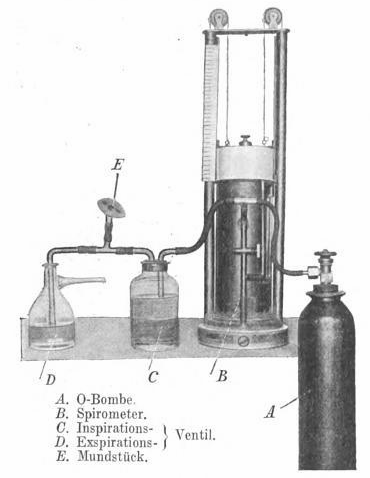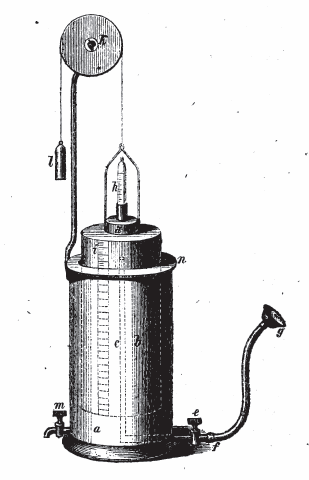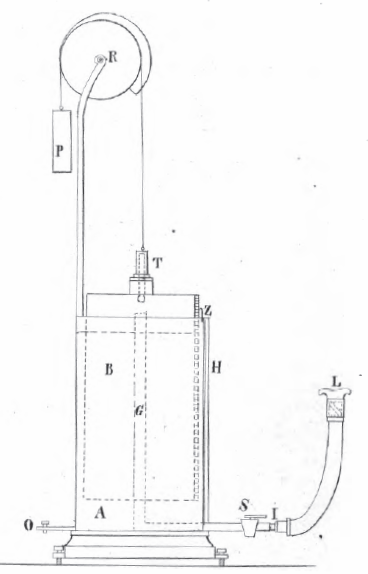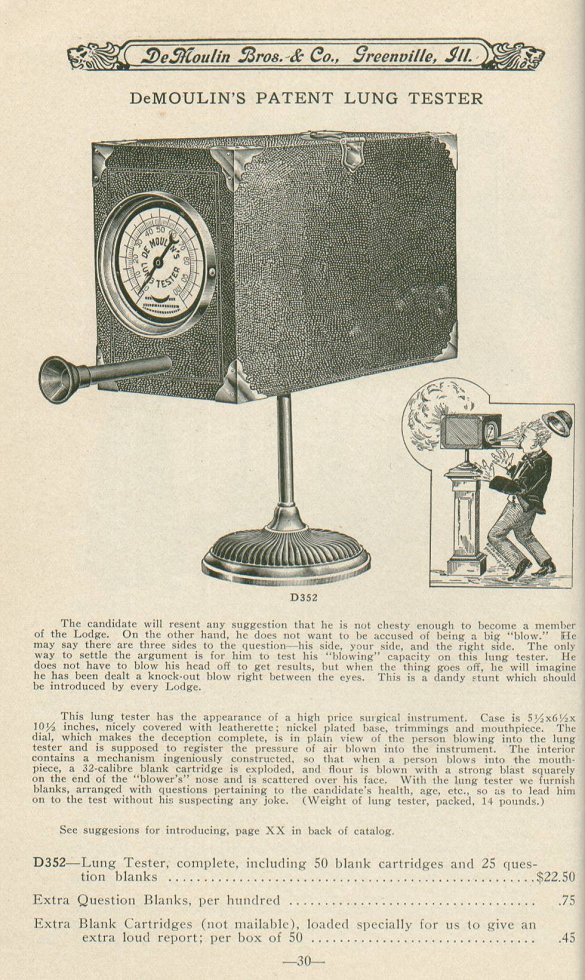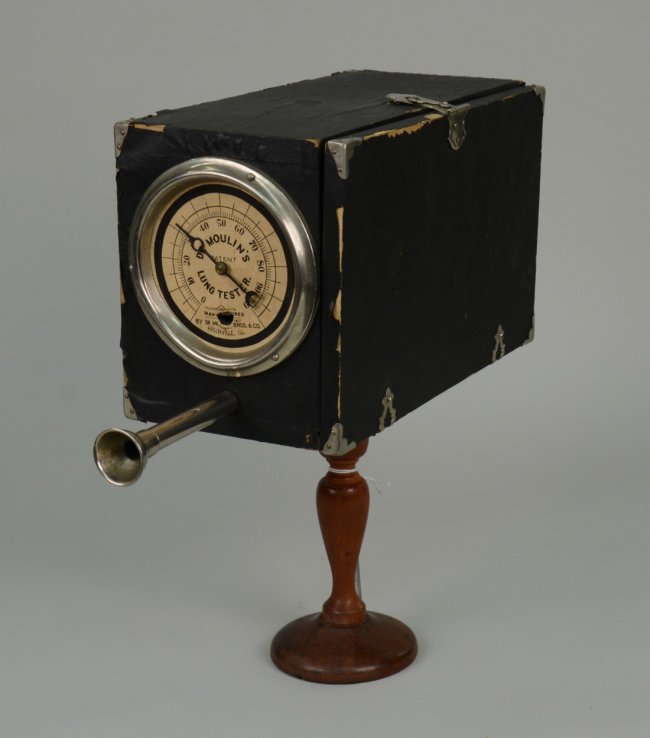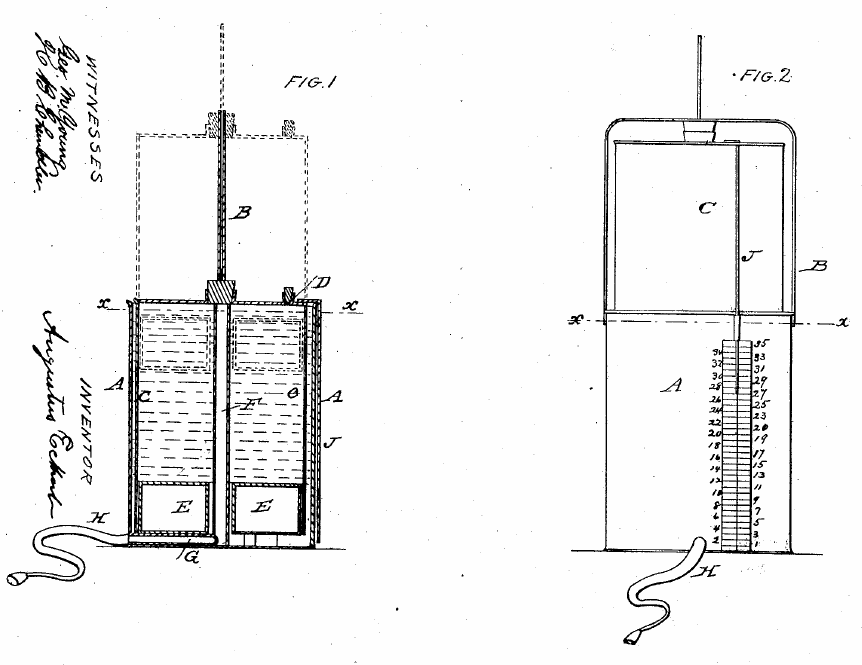From: Handbuch der Tuberkulose, Volume 2, 1914, Inhalationstherapie, by J. Lazarus and E. Aron, page 438. A system for measuring ventilation. D and C are Muller valves for unidirectional flow. The spirometer is a more-or-less exact copy of the Hutchinson spirometer.
Monthly Archives: September 2013
Spirometer, 1865, G. Simon
Spirometer, 1848
Über die Menge der ausgeathmeten Luft bei verschiedenen Menschen und ihre Messung durch das Spirometer: ein Beitrag zur medicinischen Diagnostik : mit 1 Abbildung by Gustav Simon and Julius Vogel, 1848, endplate. Spirometer manufacturer unknown.
This book was printed two years after Hutchinson’s treatise on the spirometer and the vital capacity and his design has already been modified.
Spirometer, De Moulin’s Lung Tester, “trick” spirometer, catalog listing, 1930
Spirometer, De Moulin’s Lung Tester, “trick” spirometer
From: http://www.liveauctioneers.com/item/16961660_de-moulins-lung-tester-de-moulin-bros
Manufactured by De Moulin Bros. & Co., Greenville, IL. A selection from the E. Buk Collection of Technology and Invention, Christine Burgin Gallery, NYC, October 29-December 18, 2004. A practical joke device, creating a loud explosive firing and a puff of smoke when the subject blows into the pipe.
Manometer, 1895
Spirometry, 1850
From: Die Erkenntniß der Krankheiten der Brustorgane aus physikalischen Zeiche n oder Auscultation, Percussion und Spirometrie: Nach Heribert Davie’s Vorlesungen u. eigenen Beobachtungen by Johann Friedrich Hermann Albers, 1850. Endplate.
Notably, this book was published only 4 years after Hutchinson’s treatise on the vital capacity yet his original design for the spirometer appears to have already been modified. The developer of this spirometer was not named in the text.
Spirometer, Coxeter’s, 1861
From: The physical examination of the chest in pulmonary consumption and its intercurrent diseases by Somerville Scott Alison. 1861. Page 351.
“This instrument differs from Hutchinson’s in principal, and possesses the advantage of equal accuracy, great portability and comparative cheapness. It consists of two bags, one acting as a reservoir for expired air, and the other as a measure. The air is first expired into the larger back supplied with stopcocks to retain it. The next step is to pass seriatim the air into the measure bag, and to calculate the amount. The second bag can contain from 40 to 50 cubic inches, and it is to be filled from time to time, till the whole amount is measured. This instrument only costs 26s., and Mr. Coxeter I understand, has very recently improved it.”
Spirometer, Eckert’s, 1860
US Patent 26754 by Augustus Eckert of Dayton, Ohio. 1860. A non counter-weighted water-seal spirometer. Two of the patentable features were a guide rod (B) to keep the inner bell straight and an air-filled water-tight chamber in the rim of the bottom of the inner bell (buoy, E) that served the same purpose as a counter-weight. The cork (D) was removed after a vital capacity effort had been made and recorded to allow the bell to be returned to its lower position.
Gasometer, Oxygen storage, 1887
From: Oxygen in Therapeutics. By Clyde E. Ehinger. 1887, page 65.
“For administering the combined gases after the method of Doctor Wallian, at least three gasometers are necessary; one for storing the pure nitrous oxide, another for pure oxygen, and a third for a modified mixture.
“It is possible to make one or two gasometers server the purpose, but it will not be found economy to do so, as such an arrangement will necessitate much extra work, and be a constant source of annoyance. One of the greatest objections to having but one or two gasometers is that a supply of both gases – unmixed – cannot be kept on hand – an almost fatal defect, as emergencies are constantly arising which require one or the other of the pure gases.
“The gasometers may be made of zinc or galvanized iron; the latter material, on account of its strength and durability, is preferable for the larger sizes. By using large gasometers it will not be necessary to generate so frequently.
“To a physician who has not a competent assistant to whom he can entrust the generation of gases and care of apparatus, the size of the gasometers will be found a most important item, as much of his time will be consumed in preparing chemicals, generating and commingling the gases.
“For an ordinary practice I would not advise gasometers of less than seventy-five gallons capacity, and where but three are made use of, it would be better to have the one which is used for storing the commingled gases with a capacity from 100 to 150 gallons.”
